Lakhmir Singh Biology Class 10 Solutions Control and Coordination
Lakhmir Singh Biology Class 10 Solutions Page No:92
Question 1:
What is the general name of chemical substances which bring about control and coordination in plants ?
Solution :
Phytohormones.
Question 2:
Which plant hormone is responsible for the wilting and falling of leaves ?
Solution :
Abscisic acid is responsible for the wilting and falling of leaves in plants.
Question 3:
Which plant hormone makes a stem (or shoot) bend towards light ?
Solution :
Auxin.
Question 4:
Where is the auxin hormone made in a plant stem ?
Solution :
Auxin is made at the tip of the plant stem.
Question 5:
What is the scientific name of sensitive plant ?
Solution :
Mimosa pudica.
Question 6:
Name one plant hormone that promotes growth and another plant hormone which inhibits growth.
Solution :
A plant hormone that promotes growth is Gibberellin and the hormone that inhibits growth is abscisic acid.
Question 7:
Name one example of the movement of a plant part which is very quick and can be observed easily.
Solution :
Thigmonastic movement in the leaves of touch-me-not plant is very quick and can be observed easily.
Question 8:
Name the type of chemical substances that control the growth in plants.
Solution :
Phytohormones.
Question 9:
What is the stimulus in : (a) phototropism ? (b) geotropism ? (c) chemotropism ? (d) hydrotropism ? (e) thigmotropism ?
Solution :
(a) Light.
(b) Gravity.
(c) Chemical.
(d) Water.
(e) Touch.
Question 10:
Give the scientific terms used to represent the following :
(a) Bending of a shoot towards light.
(b) Growing of roots towards the earth.
(c) Growth of a pollen tube towards ovule.
(d) Bending of roots towards water.
(e) Winding of tendril around a support
Solution :
(a) Phototropism.
(b) Geotropism.
(c) Chemotropism.
(d) Hydrotropism.
(e) Thigmotropism.
Lakhmir Singh Biology Class 10 Solutions Page No:93
Question 11:
Give one example of the movement of a plant part which is caused by the loss of water (or migration of water).
Solution :
Thigmonasty.
Question 12:
Give one example each of a plant part:
(a) which is positively hydrotropic as well as positively geotropic.
(b) which is positively phototropic but negatively geotropic.
Solution :
(a) Root.
(b) Stem.
Question 13:
Which of the following is a growth movement and which is not ?
(a) folding up of leaves of sensitive plant on touching with hand.
(b) folding up of petals of dandelion flower when light fades.
Solution :
(a) is not growth movement whereas
(b) is growth movement.
Question 14:
Name the plant part :
(a) which bends in the direction of gravity but away from light
(b) which bends towards light but away from the force of gravity
Solution :
(a) Root.
(b) Stem.
Question 15:
To which directional stimuli do :
(a) roots respond ?
(b) shoots respond ?
Solution :
(a) Gravity.
(b) Light.
Question 16:
Fill in the following blanks :
(a) A plant’s response to light is called…………..
(b) A plant’s response to gravity is called…………..
(c) Plant shoot grows upward in response to…………….
(d) Plant roots grow downward in response to…………..
(e) Tendrils wind around a support in response to……………
(f) Plant roots grow towards…….. and in the direction of force of……………
(g) A root of a plant grows downward. This is known as…………..
(h) ……….is the hormone that causes phototropism in plants
(i) The response of leaves to the sunlight is called……………
Solution :
(a) Phototropism.
(b) Geotropism.
(c) Light.
(d) Gravity.
(e) Touch.
(f) Earth, gravity.
(g) Geotropism.
(h) Auxin.
(i) Photonasty.
Question 17:
Plant parts show two types of movements, one dependent on growth and the other independent of growth. Give one example of the movement in plant parts :
which depends on growth
which does not depend on growth
Solution :
(a) Bending of stem towards light.
(b) Folding up of leaves of a sensitive plant on touching.
Question 18:
What is a plant hormone ? Name four plant hormones. State one function of each.
Solution :
The hormones that control and coordinate the activities in plants are called plant hormones. The four types of plant hormones are:
(i) Auxins – It promotes cell enlargement and cell differentiation in plants.
(ii) Gibberellines – It helps in breaking the dormancy in seeds and buds.
(iii) Cytokinins – It promotes cell division in plants.
(iv) Abscisic acid – It promotes the dormancy in seeds and buds.
Question 19:
(a) What does a root do in response to gravity ? What is this phenomenon known as ?
(b) What does a stem (or shoot) do in response to light ? What is this phenomenon known as ?
Solution :
(a) Root bends downwards in the direction of gravity; positive geotropism. (b) Stem bends towards the light; positive phototropism.
Question 20:
(a) What does a stem (or shoot) do in response to gravity ? What is this phenomenon known as ?
(b) What does a root do in response to light ? What is this phenomenon known as ?
Solution :
(a) Stem grows upward against the direction of gravity; negative geotropism.(b) Root bends away from light; negative phototropism
Question 21:
(a) What does a Mimosa pudica plant do in response to touch ? What is this phenomenon known as ?
(b) What happens to the dandelion flower (z) during daytime, and (ii) at night ? What is this phenomenon known as ?
Solution :
(a) In Mimosa pudica plant, the leaves fold up in response to touch. This phenomenon is known as thigmonasty.
(b)
(i) A dandelion flower opens up in the morning in bright light. This phenomenon is known is positive photonasty.
(ii) At night, the dandelion flower closes and this phenomenon is known as negative photonasty.
Question 22:
(a) What does a plant root do in response to water ? What is this phenomenon known as ?
(b) What happens to the moonflower (i) during daytime, and (ii) at night ? What is this phenomenon known as ?
Solution :
(a) The plant root grows towards water and the phenomenon is known as the hydrotropism.
(b)
(i) During the daytime the petals of moon flower close when there is bright light.
(ii) At night, when it is dark the petals of moon flower opens up. This phenomenon is known as photonasty.
Question 23:
What is a tendril ? Name the two types of tendrils. What does a tendril do in response to the touch of a support ? What is this phenomenon known as ?
Solution :
Tendrils are the thin, thread-like growths on the stems or leaves of climbing plants. The two types of tendrils are stem tendrils and leaf tendrils. The tendrils grow towards the things they happen to touch. This phenomenon is known as thigmotropism.
Question 24:
Name the five types of tropisms. How are tropic movements helpful to plants ? Explain with an example.
Solution :
The five types of tropisms are: Phototropism, Geotropism, Chemotropism, Hydrotropism and Thigmotropism. The various types of tropic movements help the plants to survive. Example even if a seed is planted upside down, its root will grow downwards into earth because it is positively geotropic.
Question 25:
Define chemotropism. Give one example of chemotropism. State whether this example is of positive chemotropism or negative chemotropism.
Solution :
The growth of a plant part due to chemical stimulus is known as chemotropism. For example the growth of pollen tube towards the ovule induced by a sugary substance as stimulus. This is an example of positive chemotropism.
Question 26:
Distinguish between tropic movements and nastic movements in plants. Give examples to illustrate your answer.
Solution :
Tropic movements
1. These movements are always in the direction of the stimulus.
2. These movements are slow.
3. These movements are exhibited by all parts of a plant. For example, movement of shoot towards the light and not towards gravity.
Nastic movements
1. These movements are neither away nor towards the stimulus.
2. These movements are fast.
3. These movements are exhibited by the flat organs (like leaves and petals of flowers) of a plant. For example, the bending and drooping of leaves in ‘Touch-me-not’ plant.
Question 27:
(a) What is meant by nastic movements in plants ? Give one example of nastic movements in plants.
(b) What is the difference between photonasty and thigmonasty ?
Solution :
(a) The movement of a plant part in response to an external stimulus in which the direction of response is not determined by the direction of stimulus is called nastic movement. Example: The folding up of the leaves of a sensitive plant on touching is an example of thigmonasty.
(b)
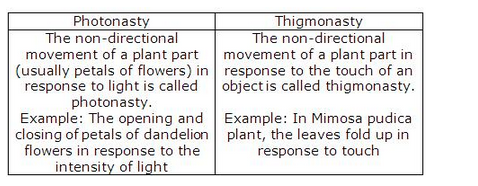
Lakhmir Singh Biology Class 10 Solutions
Page No:94
Question 28:

(a) Which figure shows the correct position taken by the parts A and B of the plant ?
(b) What type of phenomenon is exhibited by the figure chosen in (a) above ?
Solution :
(a) Figure
(ii)
(b) Geotropism.
Question 29:
Name the plant hormones which are responsible for the following effects :
(a) falling of leaves
(b) opening of stomata
(c) bending of stem towards light
(d) closing of stomata
Solution :
(a) Abscisic Acid
(b) Cytokinin
(c) Auxin
(d) Abscisic Acid
Question 30:
Name the plant organs which are :
(a) positively phototropic
(b) positively geotropic
(c) negatively geotropic
(d) positively hydrotropic
Solution :
(a) Stem
(b) Root
(c) Stem
(d) Root
Question 31:
Why is the folding up of the leaves of a sensitive plant on touching with a finger not a tropism ?
Solution :
The folding of leaves of a sensitive plant is not a case of tropism (like thigmotropism) because in this case the direction of movement of leaves does not depend on the direction of stimulus (touch).
Question 32:
Why is the closing of a dandelion flower at dusk (when it gets dark) not a tropism ?
Solution :
The closing of a dandelion flower at dusk (when it gets dark) is not a tropism because the direction of movement of petals of dandelion flower does not depend on the direction of stimulus (light).
Question 33:
(a) What is meant by ‘tropisms’ (or tropic movements) ? Explain with an example.
(b) What are the different types of tropisms ? Define each type of tropism. Write the name of stimulus in each case.
(c) How do tropisms differ from nasties (or nastic movements) ?
Solution :
(a) A growth movement ofa plant part in response to an external stimulus in which the direction of stimulus determines the direction of response is called tropism. Example – The bending of plant stem towards light is an example of positive phototropism.
(b) Different types of tropisms are:
(i) Phototropism – The movement of a plant part in response to light is called phototropism. Its stimulus is light.
(ii) Geotropism – The movement of a plant part in response to gravity is called geotropism. Its stimulus is gravity.
(iii) Chemotropism – The movement of a plant part in response to a chemical stimulus is called chemotropism. Its stimulus is chemical.
(iv) Hydrotropism – The movement of a plant part in response to a water stimulus is called hydrotropism. Its stimulus is water.
(v) Thigmotropism – The movement of a plant part in response to a touch stimulus is called thigmotropism. Its stimulus is touch.
(c)
Tropisms:
1. These movements are always in the direction of the stimulus.
2. These movements are slow.
3. These movements are exhibited by all parts of a plant.
For example, movement of shoot towards the light and not towards
Nasties:
1. These movements are neither away nor towards the stimulus.
2. These movements are fast.
3. These movements are exhibited by the flat organs (like leaves and petals of flowers) of a plant.
For example, the bending and dropping of leaves in ‘Touch-me-not’ plant.
Question 34:
(a) Define phototropism. Give one example of phototropism.
(b) How does phototropism occur in a plant stem (or shoot) ? Explain with the help of labelled diagrams.
(c) What is meant by positive phototropism and negative phototropism ? Give one example of each type.
Solution :
(a) Phototropism – The movement of a plant part in response to light is called phototropism. Example -Stem bends towards the light is positive phototropism.
(b) Phototropism in a plant stem – The bending of a plant stem towards light is an example of phototropism. The plant stem responds to light and bends towards it due to the action of auxin hormone. The auxin hormone is present at the tip of the stem of the growing plant. Auxin prefers to stay in shade away from light so when sunlight falls on the stem from one side, it gets concentrated on the opposite side. Due to more auxin, the shady side of the stem grows to be longer than the side of stem which is facing light, and makes the stem bend towards light.
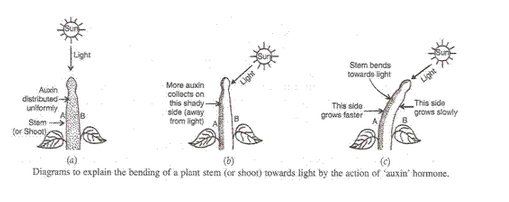
(c) The movement of a plant part towards light is called positive phototropism. Example ? the stem of the growing bends towards light. The movement of a plant part away from light is called negative phototropism. Example ? The roots of a plant move away from light.
Question 35:
(a) Define geotropism. Give one example of geotropism.
(b) What is meant by ‘positive geotropism’ and ‘negative geotropism ? Give one example of each type. Draw a labelled diagram to illustrate your answer indicating the plant part which shows positive geotropism and the plant part which shows negative geotropism.
(c) Name one plant part which exhibits positive thigmotropism.
Solution :
(a) The movement of plant part in response to gravity is called geotropism. Example – Roots grow towards gravity.
(b) If the plant part moves towards the direction of gravity, it is called positive geotropism. Example – Roots. If the plant part moves against the direction of the gravity it is negative geotropism. Example – Stem
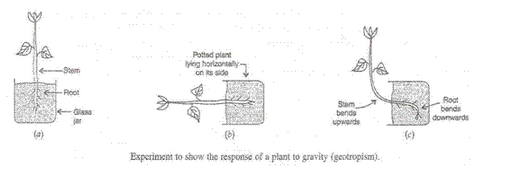
(c) Tendrils.
Question 36:
(a) How does control and coordination take place in plants ? How does it differ from that in animals ?
(b) Name five stimuli which act on plants. Name the type of tropism produced by each one of these stimuli.
(c) Define hydrotropism. Give one example of hydrotropism. State whether this example is of positive hydrotropism or negative hydrotropism. Illustrate your answer with the help of labelled diagram.
Solution :
(a) The plants do not have a nervous system but they can sense things in the presence of stimuli such as light, touch, water etc. and respond to them by the action of hormones. Thus, the plants coordinate their behavior against environmental behavior by using organic chemicals called hormones. This is called chemical coordination. The hormones in plants coordinate their behavior by affecting the growth of a part of the plant resulting in the movement of that plant part in response to a stimulus. The control and coordination in animals takes place by both nervous system and hormones.
(b)
(i) Light – Phototropism.
(ii) Gravity – Geotropism.
(iii) Chemical – Chemotropism.
(iv) Water – Hydrotropism.
(v) Touch – Thigmotropism.
(c) The movement of a plant part in response to water is called hydrotropism. Example: The roots of a plant always go towards water, this is positive hydrotropism.

Question 37:
(a) What is meant by positive tropism and negative tropism ? Explain with examples.
(b) Define thigmotropism. Give one example of thigmotropism.
(c) What is the difference between thigmotropism and thigmonasty ? Name one plant which exhibits thigmotropism and one plant which exhibits thigmonasty. What behaviour (or responses) of these plants make you think that they exhibit thigmotropism and thigmonasty respectively ?
Solution :
(a) The growth of a plant part in response to a stimulus is called positive tropism and if the growth of a plant part is away from the stimulus, then it is called negative tropism.Example: The roots of a plant go towards earth in response to gravity is an example of positive geotropism whereas stem grows away from earth against gravity is an example of negative geotropism.
(b) The directional growth movement of a plant part in response to the touch of an object is called thigmotropism.Example: Tendrils grow towards any support which they happen to touch and wind around it.
(c)

Tendrils grow towards a stimulus hence it is a directional movement which shows that it is a case of thigmotropism whereas, the folding of leaves in mimosa plant does not depend on the direction of stimulus (touch) which shows that it is an example of thigmonasty.
Lakhmir Singh Biology Class 10 Solutions Page No:115
Question 1:
Name the two systems of control and coordination in higher animals.
Solution :
Nervous system and Endocrine system.
Question 2:
What are the two parts of the vertebrate nervous system ?
Solution :
Central nervous system and Peripheral nervous system.
Question 3:
If we happen to touch a hot object unknowingly, we immediately pull back our hand. What is this type of action known as ?
Solution :
Reflex action.
Question 4:
Name the three components of a neuron (or nerve cell).
Solution :
Cell body, dendrites and axon.
Question 5:
(a) What are the short fibres of a neuron known as ?
What is the long fibre of a neuron known as ?
Solution :
(a) Dendrites.
(b) Axon.
Question 6:
Name the most important part of the human brain.
Solution :
Cerebrum.
Question 7:
Which part of the brain maintains posture and balance of the body ?
Solution :
Cerebellum.
Question 8:
State one function each of cerebellum and pons.
Solution :
Function:
(a) Cerebellum ? It helps in maintaining posture and balance of the body.
(b) Pons ? It regulates the respiration process.
Question 9:
Name one hormone secreted by the pituitary gland.
Solution :
Growth hormone.
Question 10:
Where are hormones made in the human body ?
Solution :
Endocrine glands.
Question 11:
What is the name of the system of glands which produces hormones ?
Solution :
Endocrine system.
Question 12:
Which gland secretes the growth hormone ?
Solution :
Pituitary gland.
Question 13:
Name the hormones secreted by (a) testes, and (b) ovaries
Solution :
(a) Testosterone.
(b) Progesterone and oestrogen.
Question 14:
What are the scientific names for the following receptors in animals ?
(a) receptors for light
(b) receptors for heat
(c) receptors for sound
(e) receptors for smell
(e) receptors for taste
Solution :
(a) Photoreceptors.
(b) Thermoreceptors.
(c) Phonoreceptors.
(d) Olfactory receptors.
(e) Gustatory receptors.
Question 15:
Name the disease caused by the deficiency of insulin hormone in the body.
Solution :
Diabetes.
Question 16:
Name, the disease caused by the deficiency of thyroxine hormone in the body.
Solution :
Goitre.
Question 17:
Which halogen element is necessary for the making of thyroxine hormone by the thyroid gland ?
Solution :
Iodine.
Question 18:
Why are some patients of diabetes treated by giving injections of insulin ?
Solution :
The people having severe diabetes are treated by giving injections of insulin.
Question 19:
What is the name of in-built ‘arrangement’ in our body which controls the timing and amount of hormones released by various endocrine glands in the body ?
Solution :
Feedback mechanism.
Question 20:
Name one gland each :
(a) which acts only as an endocrine gland.
(b) which acts only as an exocrine gland.
(c) which acts both as an endocrine gland as well as an gxocrine gland.
Solution :
(a) Thyroid gland.
(b) Salivary glands.
(c) Pancreas.
Question 21:
What part does the diet play in helping us to have a healthy thyroid gland ?
Solution :
Diet provides iodine for making thyroxine hormone which keeps the thyroid gland healthy.
Question 22:
If sugar is detected in the urine of a person, name the disease he is suffering from.
Solution :
Diabetes.
Question 23:
Name two parts of the body which contain receptors of chemical stimuli.
Solution :
Nose and Tongue.
Question 24:
Which part of the eye contains cells which are sensitive to light ?
Solution :
Retina.
Question 25:
What are the two main communications systems in an animal’s body ?
Solution :
Nervous system and endocrine system.
Question 26:
Which one term in each of the following includes the other three ?
(a) thyroid, ductless gland, thymus, pituitary, ovary
(b) adrenalin, insulin, hormone, thyroxine, estrogen
Solution :
(a) Ductless gland.
(b) Hormone.
Question 27:
Which parts of the body form the central nervous system ?
Solution :
Brain and spinal cord.
Question 28:
Give three examples of reflex actions.
Solution :
(i) Knee jerk reflex.
(ii) Sneezing.
(iii) Coughing.
Question 29:
Why do you need iodine in your diet ?
Solution :
Because iodine is necessary for making thyroxine hormone.
Question 30:
State whether coughing is a voluntary action or reflex action.
Solution :
Reflex action.
Question 31:
Fill in the following blanks with suitable words :
(a) The two examples of effectors are…………. and………………
(b) Our…………. system allows Us to react to our surroundings. Information from receptors passes
along…………. neurons to our brain. Our brain sends impulses along………… neurons to our muscles.
(c) A neuron which carries an impulse to the brain is called a……………….
(d) The neuron which carries a message for action to a muscle or gland is known as a……………….
Solution :
(a) Muscle; glands.
(b) Nervous; sensory; motor.
(c) Sensory.
(d) Motor.
Lakhmir Singh Biology Class 10 Solutions Page No:116
Question 32:
(a) What are the various sense organs in our body ?
(b) What is meant by receptors and effectors ? Give two examples of each.
Solution :
(a) There are 5 sense organs: Eyes, ears, nose, tongue and skin.
(b) A receptor is a cell (or a group of cells) in a sense organ which is sensitive to a particular type of stimulus (or a particular type of change in the environment).
Example: Photoreceptors and Phonoreceptors.An effecter is the part of the body which can respond to the stimulus according to the instructions sent from the nervous system (spinal cord and brain).
Example: Muscles and glands.
Question 33:
(a) What is spinal cord ? What is its main function ?
(b) Give the functions of medulla.
Solution :
(a) Spinal cord is a cylindrical structure which begins in continuation with medulla and extends downwards. Its function is the conduction of nerve impulses to and from the brain and it is concerned with spinal reflex actions.
(b) The medulla controls various involuntary actions such as heart beat, breathing, blood pressure and peristaltic movements of the elementary canal.
It is also the controlling centre for reflexes such a swallowing, coughing, sneezing, secretion of saliva and vomiting.
Question 34:
(a) Name the three types of nerves which constitute the peripheral nervous system.
(b) What is the difference between a reflex action and walking ?
(c) How do we detect the smell of an incense stick (agarbatti) ?
Solution :
(a) The three types of nerves which make up the peripheral nervous system are: spinal nerves, cranial nerves and visceral nerves.
(b)
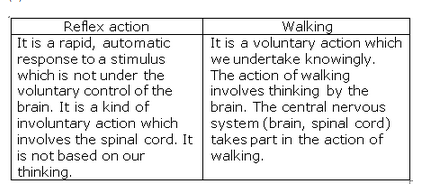
(c) When the agarbatti burns, it produces vapours having a characteristic pleasant smell which is detected by the olfactory receptors present inside our nose. The action of smell of agarbatti or receptors sets off chemical reactions which generate electrical impulses. The sensory neurons carry these electric al impulses to the sensory area of fore brain called cerebrum. This makes us detect the smell of burning agarbatti.
Question 35:
(a) What substances are made by endocrine glands ?
(b) What is the function of receptors and effectors in our body ?
Solution :
(a) Hormones are made by endocrine glands.
(b) Receptors are the special cells present in our sense organs which detect all the information from our environment and feed it to the nervous system. An effector responds to electrical impulses sent from the nervous system through motor nerves.
Question 36:
(a) Name the hormones secreted by the following endocrine glands :
(i) Thyroid gland
(ii) Parathyroid glands
(iii) Pancreas
(iv) Adrenal glands
(b) Write the functions of testosterone and oestrogen hormones.
Solution :
(a)
(i) Thyroxine
(ii) Parathromone
(iii) Insulin
(iv) Adrenaline.
(b) The function of testosterone hormone is to control the development of male sex organs and male features such as deeper voice, moustache, body hairs etc. The function of oestrogen is to control the development of female sex organs and female features such as feminine voice, soft skin and mammary glands.
Question 37:
(a) Write the names of the regions in hindbrain. Give one function of each region.
(b) Name the functions of cerebrum.
Solution :
(a) Hindbrain has 3 regions:
(i) Pons: It takes part in regulating respiration.
(ii) Cerebellum: It helps in maintaining posture and balance of the body. It enables us to make precise and accurate movements.
(iii) Medulla: The medulla controls various involuntary actions such as heart beat, breathing, blood pressure and peristaltic movements of the elementary canal. It is also the controlling centre for reflexes such a swallowing, coughing, sneezing, secretion of saliva and vomiting.
(b) Function of cerebrum: It is the main thinking part of the brain. It is the site of our faculties such as learning, reasoning, intelligence, personality and memory. All our thoughts, sensation, actions and movements are controlled by cerebrum.
Question 38:
(a) The human brain can be broadly divided into three regions. Name these three regions.
(b) What is cranium ? What is its function ?
Solution :
(a) The 3 regions of human brain are
(i) Forebrain
(ii) Midbrain and
(iii) Hindbrain.
(b) Cranium is a bony box in the skull in which the brain is present. Its function is to protect the brain.
Question 39:
(a) How does chemical coordination take place in human beings ?
(b) Why is the use of iodised salt advisable ?
Solution :
(a) The chemical coordination in animals takes place through the actions of chemicals called hormones which are release directly into the blood and are carried by the blood circulatory system to other parts of the body. Hormones travel all over the body but affect only particular organs at particular places which are called target organs. The organs control and coordinate several functions of animal body such as growth, development, metabolism, behavior and secondary sexual characteristics, etc.
(b) Iodine is necessary for the thyroid gland to make thyroxine hormone which regulates the metabolism of carbohydrates, fats and proteins so as to produce the best balance for the growth. Iodised salt is advisable as it contains appropriate amounts of iodine compounds needed by the thyroid gland to make sufficient thyroxine hormone for the body and hence goitre disease can be prevented.
Question 40:
What is the function of insulin hormone ? What type of patients are given insulin injections ?
Solution :
The function of insulin hormone is to lower the blood sugar level (or blood glucose level). People having severe diabetes are treated by giving injections of insulin.
Question 41:
Compare the nervous system and endocrine system (hormonal system) for control and coordination in humans.
Solution :
Nervous System
It is a system to coordinate the activities of bodies. It helps all other system of our body to work together. It receives information from the surroundings, processes it, interprets it and then responds accordingly.
Endocrine System
It is a group of endocrine glands which produces various hormones that helps in coordinating the activities of our body. The hormones produced by the endocrine glands act as messengers between the nervous system and the organs of our body.
Question 42:
State the functions of the following hormones :
(a) Thyroxine
(b) Adrenaline
(c) Growth hormone
Solution :
(a) Thyroxine ? The function of this hormone is to control the rate of metabolism of carbohydrates, fats and proteins in the body.
(b) Adrenaline ? Its function is to regulate heart rate, breathing rate, blood pressure and carbohydrate metabolism.
(c) Growth hormone ? It controls the growth of the human body.
Question 43:
Write the names of all the major endocrine glands present in the human body. Which of these glands also function as exocrine glands ?
Solution :
The endocrine gland present in the human body are:
(i) Pineal gland
(ii) Hypothalamus
(iii) Pituitary
(iv) Thyroid
(v) Parathyroid
(vi) Thymus
(vii) Pancreas
(viii) Adrenal glands
(ix) Testes (in males)
(x) Ovaries (in females). Pancreas, testes and ovaries function as exocrine glands.
Question 44:
Match the hormones given in column I with their functions given in column II :

Solution :
(i) d
(ii) c
(iii) e
(iv) a
(v) b
Question 45:
A person walks across a room in barefeet and puts his foot on a drawing pin lying on the floor. He lets out a cry. Explain what happens in his nervous system in bringing about this response.
Solution :
It is an example of reflex action. The stimulus here is drawing pin lying on the floor. The pain is sensed by the receptors in the skin which triggers and impulse in a sensory neuron and transmits the message to the spinal cord. The impulse is passed onto a relay neuron, which in turn, passes it to the motor neuron. The motor neuron passes the impulse to a muscle in the feet. The muscle then contracts and pulls our feet away from the drawing pin.
Question 46:
In what ways are puberty and adolescence result of the activity of some glands in the human body ?
Solution :
Puberty and adolescence are the results of sex glands in human beings. In males, testes make male sex hormones called testosterone which is associated with male puberty, which the boys attain an age of 13-14 years. In females the oestrogen hormone is responsible for all the changes associated with female puberty which the girl attains at an age of 10-12 years.
Question 47:
List three ways in which neurons are similar to other cells.
Solution :
Neurons and other cells have a cell membrane, cytoplasm and a nucleus.
Question 48:
Explain the difference between each of the following pairs of terms :
(a) receptor and effector
(b) cerebrum and cerebellum
Solution :
(a)
Receptor
A receptor is a cell (or a group of cells) in a sense organ which is sensitive to a particular type of stimulus (or a particular type of change in the environment).
Example: Photoreceptors and Phonoreceptors.
Effector
An effector is the part of the body which can respond to the stimulus according to the instructions sent from the nervous system (spinal cord and brain).
Example: Muscles and glands.
(b)
Cerebrum
(i) It is a part of forebrain.
(ii) It is the main thinking part of the brain. All our thoughts, sensation, actions and movements are controlled by cerebrum.
Cerebellum
(i) It is a part of hindbrain.
(ii) It helps in maintaining posture and balance of the body. It enables us to make precise and accurate movements.
Question 49:
What is the difference between a voluntary and an involuntary action ? Which kind of action is digestion ? Explain your choice.
Solution :

Digestion is an involuntary action as it does not involve the thinking process and is performed unknowingly by our digestive system.
Question 50:
What does CNS stand for ? Which part of CNS :
(a) consists of two cerebral hemispheres, and
(b) has spinal nerves attached to it ?
Solution :
(i) CNS – Central nervous system.
(ii)
(a) Cerebrum
(b) Spinal cord.
Question 51:
Which hormone :
(a) prepares the body for action ?
(b) controls the amount of glucose in blood ?
(c) gives boys a deep voice ?
(d) gives girls soft skin ?
Solution :
(a) Adrenaline.
(b) Insulin.
(c) Testosterone.
(d) Oestrogen.
Lakhmir Singh Biology Class 10 Solutions Page No:117
Question 52:
When you smell a favourite food your mouth begins to water (that is, you secrete saliva). Write down what the following are examples of :
(a) the smell of the food
(b) the cells in your nasal passages which perceive the smell
(c) the gland which is stimulated to secrete saliva.
Solution :
(a) Stimulus.
(b) Receptors (Olfactory).
(c) Effector (Salivary glands).
Question 53:
(a) Name the structural and functional unit of nervous system.
(b) Draw a flow chart to show the classification of nervous system into various parts.
(c) What is autonomic nervous system ? What is its function ?
(d) What is voluntary nervous system ? Explain the working of voluntary nervous system with an example.
Solution :
(a) Te structural and functional unit of nervous system is neuron.
(b)

(c) Autonomic nervous system means self governing nervous system. Its function is to control and regulate the functions of the internal organs of our body involuntarily.
(d) The voluntary nervous system is a system which helps us to take voluntary actions which are under the conscious control of the brain. Example: If a student is getting late for school and sees his watch. He starts walking fast. In this process, the eyes see the time and send the information to the brain through the sensory nerves. The brain analyses the information and sends the instructions to walk faster to the muscle of our legs through the motor nerves. The muscles of the legs act accordingly and make the student walk faster.
Question54:
(a) What is a reflex action ? Explain with the help of an example.
(b) Define reflex arc. Give the flow chart of a spinal reflex arc.
(c) How are involuntary actions and reflex actions different from each other ?
Solution :
(a) The rapid, automatic response to a stimulus which is not under the voluntary action of the brain is called reflex action.Example: Moving our hand away on touching a hot plate.
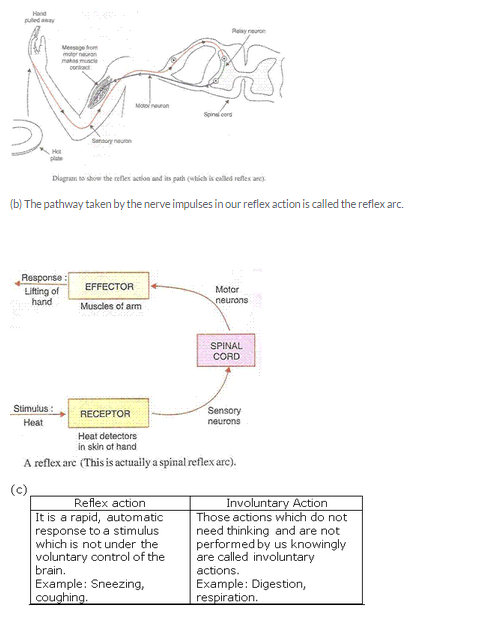
Question 55:
(a) What is the function of our nervous system ?
(b) What are the main organs of the human nervous system ? Draw a labelled diagram to show the main organs of the human nervous system.
(c) How does the human nervous system work ? Explain.
Solution :
(a) (i) The function of the nervous system is to coordinate the activities of our body.
(ii) It helps all other systems of our body to work together.
(iii) It receives information from the surroundings, processes it, interprets it and then responds accordingly.
(b) The main organs of the nervous system are; brain, spinal cord and nerves.
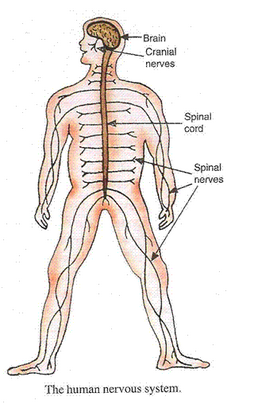
(c) When the sense organ in our body is affected, it sends the message to the brain in the form of electrical impulses through the sensory neurons. The brain analyses this message and decides the action to be taken. The brain then sends out instructions to the muscles of the concerned body parts through motor nerves and the concerned body part acts accordingly.
Question 56:
(a) What is a neuron ? Draw a labelled diagram of a neuron.
(b) What is a synapse ? What happens at the synapse between two neurons ? How are the messages carried across a synapse ? Explain with the help of a labelled diagram.
Solution :
(a) The unit which makes up the nervous system is called a neuron.
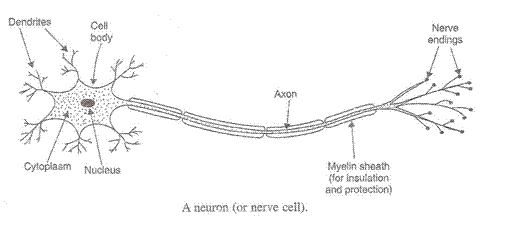
(b) A microscopic gap between a pair of adjacent neurons over which nerve impulses pass when going from one neuron to the next is called a synapse. Synapse between two neurons acts as a one way valve which allows electrical impulses to pass in one direction only. This happens as follows: When an electrical impulse coming from the receptor reaches the end of the axon of sensory neuron, then the electrical impulse releases tiny amount of a chemical substance called neuro transmitter substance into the synapse between two adjacent neurons. This substance crosses the synapse and starts a similar electrical impulse in the dendrite of the next neuron. In this way, the electrical impulses passes from one neuron to the next across the synapse.
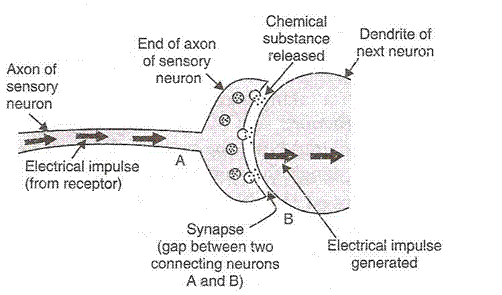
Question 57:
(a) Name two systems which taken together perform the functions of control and coordination in human beings.
(b) What does the central nervous system in humans consist of ? What is the job of the central nervous system ?
(c) Give the various functions of brain.
Solution :
(a) Nervous system and endocrine system.
(b) The central nervous system consists of the brain and spinal cord. The work of the CNS is to direct incoming messages to the motor neurons that are connected to the part of the body which will respond to a stimulus. It is involved in complicated responses where both (brain and spinal cord) work. It enables a person to give a more appropriate and more intelligent response to various situations.
(c)
(i) The brain receives information carrying nerve impulses from all the sensory organs of the body.
(ii) It responds to the impulses brought in by sensory organs by sending its own instructions through motor nerves to the muscles and glands causing them to function accordingly.
(iii) It correlates the various stimuli from different sense organs and produces the most appropriate and intelligent response.
(iv) It coordinates the body activities so that the mechanisms and chemical reactions of the body work together efficiently.
(v) It stores information so that behavior can be modified according to the past experience.
Question 58:
(a) Write the names of five endocrine glands found in the human body. Name the hormones secreted by each gland.
(b) How do hormones reach the organs they control ?
(c) Name the gland which controls the secretion of hormones from the pituitary.
(d) How does our body respond when adrenaline is secreted in large amounts into the blood ?
(e) Name the disease which occurs in adults due to the deficiency of iodine in the diet. What is the main symptom of this disease ?
Solution :
(a)
(i) Pituitary – Growth.
(ii) Thyroid – Thyroxine.
(iii) Pancreas – Insulin.
(iv) Adrenal – Adrenaline.
(v) Testes – Testosterone.
(b) The endocrine glands do not have ducts to secrete their hormones. They release hormones directly into the blood of a person and reach the concerned body part through the blood and act on it.
(c) Hypothalamus.
(d) The adrenaline hormone prepares our body to function at maximum efficiency during emergency situations like danger, anger etc. This adrenaline hormone increases our heartbeat, breathing rate, blood flow into muscles and causes liver to put more stored glucose into our blood. All these actions produce a lot of energy in our body and help us to cope up the emergency situations. Thus, when adrenaline is secreted in large amounts it prepares our body for action.
(e) Goitre – The neck of the person appears to be swollen due to the enlargement of thyroid gland located in the neck.